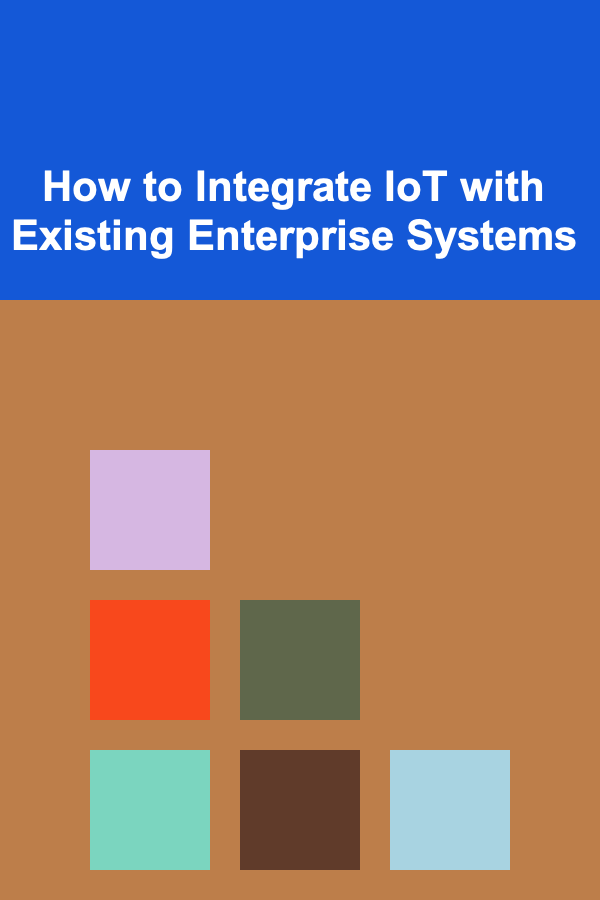
How to Integrate IoT with Existing Enterprise Systems
ebook include PDF & Audio bundle (Micro Guide)
$12.99$10.99
Limited Time Offer! Order within the next:

The integration of the Internet of Things (IoT) into existing enterprise systems has become a strategic priority for many businesses looking to enhance operational efficiency, improve decision-making, and unlock new revenue streams. As more devices and sensors are connected to the internet, companies are increasingly able to capture and analyze data in real time, offering unprecedented visibility into operations, customer behavior, and overall business performance.
However, integrating IoT with legacy enterprise systems is not without challenges. Existing systems, which may include Customer Relationship Management (CRM) systems, Enterprise Resource Planning (ERP) systems, and various business intelligence tools, were often not designed to handle the volume and complexity of data generated by IoT devices. As a result, companies must adopt a thoughtful approach to ensure that their IoT initiatives are successful.
In this article, we will explore the steps, best practices, and challenges associated with integrating IoT with existing enterprise systems. We will also look at the benefits, use cases, and technologies that are driving this transformation.
Understanding the Basics of IoT and Enterprise Systems
1.1. What is the Internet of Things (IoT)?
IoT refers to the network of physical devices, vehicles, appliances, and other objects embedded with sensors, software, and other technologies that enable them to collect and exchange data. These devices range from smart thermostats to industrial machines, all of which can be interconnected to share information and make autonomous decisions.
IoT can provide enterprises with real-time insights into their operations, such as tracking inventory, monitoring machinery performance, or analyzing customer behavior. This influx of data allows companies to optimize processes, improve resource allocation, and create personalized experiences for customers.
1.2. What are Enterprise Systems?
Enterprise systems are large-scale software solutions that organizations use to manage and streamline critical business functions. These systems include:
- Enterprise Resource Planning (ERP): Integrates core business processes such as finance, human resources, supply chain management, and inventory control.
- Customer Relationship Management (CRM): Helps manage interactions with current and potential customers, centralizing customer data and sales activities.
- Business Intelligence (BI): Provides tools for analyzing business data and generating reports that support decision-making processes.
Enterprise systems have traditionally operated in silos, focusing on specific business functions. However, as IoT becomes more prevalent, there is an increasing need to break down these silos and integrate IoT data with enterprise systems to gain more holistic insights and enable smarter decision-making.
The Importance of Integrating IoT with Existing Enterprise Systems
Integrating IoT with enterprise systems can offer a variety of benefits, including:
2.1. Improved Operational Efficiency
One of the most significant advantages of IoT integration is the ability to automate processes and improve operational efficiency. For example, IoT devices can provide real-time data on machinery performance, allowing companies to detect and address maintenance issues before they lead to expensive breakdowns. This can reduce downtime, improve production schedules, and ensure that resources are being used optimally.
2.2. Enhanced Decision-Making
IoT provides an unprecedented amount of data that can help business leaders make informed, data-driven decisions. By integrating IoT data with business intelligence systems, companies can gain real-time insights into customer behavior, inventory levels, and supply chain performance. This allows organizations to make proactive decisions that improve profitability and customer satisfaction.
2.3. Better Customer Experiences
Integrating IoT with CRM systems can lead to better customer experiences by providing personalized services based on real-time data. For example, retailers can use IoT sensors to track customer preferences and behaviors in-store, and then integrate that information with their CRM system to provide tailored promotions, recommendations, and offers. Similarly, manufacturers can use IoT to offer predictive maintenance services to customers, ensuring that their products stay operational for longer periods.
2.4. New Revenue Streams
IoT integration can open the door to new revenue streams. For example, companies can offer IoT-enabled products as a service, providing ongoing maintenance and upgrades as part of a subscription model. In addition, data collected from IoT devices can be sold or used to create new business models that were previously not possible.
Challenges of Integrating IoT with Enterprise Systems
While the benefits of IoT integration are clear, the process is not without challenges. Some of the most common obstacles organizations face when integrating IoT with their existing enterprise systems include:
3.1. Data Overload
IoT devices generate vast amounts of data, and managing this data can quickly become overwhelming. Existing enterprise systems may not be equipped to handle the sheer volume of data generated by IoT devices, leading to performance issues and inefficiencies. To address this, businesses must implement data management strategies, such as filtering and pre-processing data, to ensure that only relevant data is fed into the enterprise systems.
3.2. Legacy Systems Compatibility
Many enterprise systems were designed years before the rise of IoT, and they may not be equipped to seamlessly integrate with IoT devices and platforms. Legacy systems can pose significant challenges in terms of compatibility and scalability. To overcome this, organizations may need to upgrade or replace outdated systems, or use middleware solutions that facilitate communication between IoT devices and legacy software.
3.3. Security Concerns
Integrating IoT with enterprise systems introduces new security risks. IoT devices are often vulnerable to cyberattacks, and integrating them with enterprise systems can potentially expose sensitive data to breaches. Ensuring that both IoT devices and enterprise systems are secure is critical. This may involve implementing robust encryption protocols, conducting regular security audits, and establishing clear policies for data access and sharing.
3.4. Data Integration and Standardization
IoT devices can use a variety of communication protocols and data formats, making it difficult to integrate IoT data with existing enterprise systems. Standardizing data formats and ensuring that devices can communicate with enterprise systems is a critical step in the integration process. This may involve using data transformation tools, adopting common IoT standards, or implementing API-based integration platforms that enable seamless data exchange.
Steps to Integrate IoT with Existing Enterprise Systems
Integrating IoT with enterprise systems requires careful planning and execution. Below are the key steps organizations can follow to successfully integrate IoT with their existing enterprise systems.
4.1. Define Clear Objectives
Before beginning the integration process, it's essential to define clear objectives. What do you hope to achieve by integrating IoT with your enterprise systems? Are you looking to improve operational efficiency, enhance customer experiences, or gain real-time insights into your supply chain? Defining your objectives will guide your integration efforts and help you measure success.
4.2. Assess Current Systems
Next, assess your existing enterprise systems to determine their compatibility with IoT devices. Identify any gaps in functionality or performance that may hinder integration. It may also be helpful to map out the data flow between your enterprise systems and IoT devices, to ensure that the data can be captured, processed, and used effectively.
4.3. Choose the Right IoT Platform
Selecting the right IoT platform is crucial for successful integration. The platform should support the types of devices and sensors you plan to use and provide the necessary tools for integrating with your enterprise systems. Look for platforms that offer scalability, security, and support for standard protocols, as these features will make the integration process smoother.
4.4. Implement Data Management and Processing
Once the IoT devices are connected to your enterprise systems, you will need to implement a data management strategy. This involves determining how to collect, store, and process the data generated by the devices. You may also need to implement analytics tools to extract actionable insights from the data. The goal is to ensure that the data is structured and relevant for decision-making.
4.5. Ensure Security and Compliance
Security should be a top priority throughout the integration process. Ensure that all IoT devices are properly secured, with robust encryption protocols in place. Additionally, implement security measures within your enterprise systems to prevent unauthorized access to sensitive data. It's also important to consider regulatory compliance, especially if you're handling personal or financial data. Be sure that your integration efforts comply with applicable laws and regulations.
4.6. Test and Monitor the Integration
Before fully deploying the IoT integration, conduct thorough testing to ensure that everything is working as expected. Test the communication between devices and enterprise systems, validate data accuracy, and check for performance issues. Once the integration is live, continuously monitor the system to identify any issues or inefficiencies, and make adjustments as needed.
4.7. Train Employees and Stakeholders
The success of an IoT integration project depends on how well employees and stakeholders understand the new system. Provide training to ensure that all relevant staff are equipped to work with the new technology and can use it to its full potential. This will help drive adoption and maximize the benefits of the IoT integration.
Best Practices for IoT Integration
Here are some best practices to keep in mind as you work to integrate IoT with your enterprise systems:
- Start Small: Begin with a pilot project or a single IoT application to test the integration process before scaling up.
- Use APIs: Application Programming Interfaces (APIs) make it easier to connect IoT devices with enterprise systems. They allow for seamless data exchange and can help ensure that data flows smoothly between platforms.
- Focus on Scalability: Choose systems and platforms that are scalable so that your integration efforts can grow alongside your business.
- Implement Automation: Use automation tools to streamline processes and reduce the risk of human error. Automation can also help ensure that IoT data is processed and acted upon in real time.
- Maintain Flexibility: The IoT landscape is constantly evolving, so it's essential to keep your integration strategy flexible. Stay updated on new IoT technologies and protocols, and be ready to adapt your systems as needed.
Conclusion
Integrating IoT with existing enterprise systems is an essential step for businesses looking to stay competitive in an increasingly digital world. While the process comes with challenges, the benefits of enhanced efficiency, improved decision-making, and new revenue opportunities make it well worth the effort.
By defining clear objectives, assessing current systems, choosing the right IoT platform, and following best practices for data management and security, businesses can successfully integrate IoT into their enterprise systems and unlock the full potential of connected devices.
As IoT continues to evolve, organizations must remain adaptable and committed to ongoing improvements, ensuring that their enterprise systems can handle the growing demands of the IoT ecosystem. With the right approach, businesses can position themselves at the forefront of the digital transformation and achieve long-term success in the connected world.
Reading More From Our Other Websites
- [Organization Tip 101] How to Achieve a Professional Finish with Low VOC Paint
- [Paragliding Tip 101] Future Trends in Paragliding Certification: Emerging Technologies and New Safety Protocols
- [Organization Tip 101] How to Check and Replace Your HVAC Filter Like a Pro
- [Home Budget Decorating 101] How to Use Color to Decorate on a Budget
- [Home Budget 101] How to Budget for Utilities as a Homeowner: A Seasonal Guide
- [Home Cleaning 101] How to Clean and Care for Houseplants: From Dusty Leaves to Thriving Greenery
- [Home Cleaning 101] How to Keep Your Home Dust-Free in High-Allergy Seasons
- [Personal Care Tips 101] How to Make Concealer Last Longer
- [Home Budget Decorating 101] How to Decorate a Small Apartment Without Breaking the Bank
- [Home Lighting 101] How to Create a Functional Lighting Scheme for Your Home's Hallways

How to Build Wealth in Your 30s: A Step-by-Step Guide
Read More
How to Create a Family Recipe Book with Generational Favorites
Read More
How to Explore Mindfulness Practices as a Family
Read More
How to Stage a Home with Bold and Eclectic Design
Read More
How to Use a Work Planner for Time Blocking Mastery
Read More
How to Build a Supportive Community for Art Therapists
Read MoreOther Products

How to Build Wealth in Your 30s: A Step-by-Step Guide
Read More
How to Create a Family Recipe Book with Generational Favorites
Read More
How to Explore Mindfulness Practices as a Family
Read More
How to Stage a Home with Bold and Eclectic Design
Read More
How to Use a Work Planner for Time Blocking Mastery
Read More